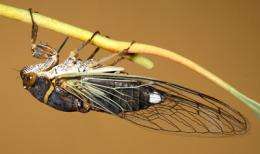The cicada Diceroprocta semicincta sings its zzsssstttt song during Tucson's hot summer days. (Credit: Adam Fleishman/cometmoth.com)
(PhysOrg.com) -- John McCutcheon remembers the song of the cicada - the loudest song in the insect world - as the sound track to countless summer hours spent playing outside his childhood home in Rockford, Ill.
So when McCutcheon, a molecular biologist at the University of Arizona, heard the zzsssstttt of cicadas singing outside of his Tucson office, he again took notice - but this time as a curious scientist rather than as a playful boy.
In collaboration with UA Regents' Professor of ecology and evolutionary biology Nancy Moran, McCutcheon began investigating the relationship between cicadas and the symbiotic bacteria that live inside them.
"This project provides an example of how interesting science may be happening right outside your front door," said McCutcheon, a postdoctoral research associate at the UA's Center for Insect Science.
He collected local cicadas, Diceroprocta semicincta, some from mesquite trees growing right outside his office in the Life Sciences South building.
McCutcheon admires cicadas for their success. "Certain cicada species occur in overwhelming numbers," he said. "And they are estimated to be the most abundant herbivores in terms of both their total weight and the total number of individuals in some North American forests."
The noisy insects achieve such success despite their reliance on a nutrient-poor diet. Before emerging en masse at regular intervals, cicadas spend most of their lives (from two to 17 years) underground feeding solely on the sap of plant roots. Sap is the most nutrient-poor and unbalanced part of plants.
The juvenile cicadas supplement their diet by maintaining a symbiotic relationship with two species of specialized bacteria that live inside specialized cells inside the insects. The cicadas provide food and shelter for the bacteria. In turn, the bacteria produce essential nutrients, primarily amino acids, that are not present in plant sap.
Most sap-sucking insects studied so far have such bacterial symbionts. Although the bacterial species vary somewhat from one species of insect to the next, many of the bacteria have similar features.
However, McCutcheon, Moran and UA undergraduate Bradon McDonald found an unusual bacterial symbiont living inside cicadas.
The symbiont, Hodgkinia cicadicola, has the smallest collection of genes ever found for a cellular organism.
McCutcheon, McDonald and Moran published their most recent findings about cicadas' symbiotic bacteria in the Sept. 8 issue of the Proceedings of the National Academy of Science. Some of their earlier findings are published in the July 17, 2009, issue of PLoS Genetics.
Besides having a tiny number of genes, Hodgkinia's genome is unusual in other ways, the researchers found. The bacteria's DNA has a high proportion of guanine and cytosine - two of the four chemical bases of DNA. Scientists previously thought that the smaller a bacterial genome, the less guanine and cytosine its DNA would have.
"We don't yet understand the significance of this exception," McCutcheon said. "But it goes against everything we thought we understood about the relationship between bacterial genome size and guanine and cytosine contents."
In addition, the code Hodgkinia uses to translate gene sequences into proteins is different than the code used by most other organisms.
Hodgkinia can also make the complex vitamin B12, which is why McCutcheon named the bacteria after Dorothy Crowfoot Hodgkin, the x-ray crystallographer who won the Nobel Prize for figuring out vitamin B12's structure.
The relationship between sap-sucking insects and some of their symbionts can be traced back more than 200 million years, he said.
"These incredibly small genomes are beginning to blur the distinction between autonomous life and organelles," McCutcheon said.
Organelles are specialized units within cells. The energy-producing organelles, chloroplasts and mitochondria, are thought to have originally been bacteria that started living within other single-celled organisms.
"Some chloroplasts have more genes than Hodgkinia," he said.
"The next step for this project is trying to understand how these bacteria live with so few genes," McCutcheon said.
Provided by University of Arizona (news : web)





















